
Image source: Wikimedia Commons
More than any other cutting-edge technology, augmented reality (AR) causes consumers to view a brand as innovative, according to a survey commissioned by Diffusion.
By superimposing computer-generated images onto smartphone cameras or other screens, AR blends physical and digital worlds and allows users to shape their experiences, unlike virtual reality that’s entirely digital. Pokémon Go offered an early popular example of AR, but consumers now want brands to apply AR to more practical applications, such as showing what furniture looks like in their home or what clothing or make-up looks like on them.
About one-fourth (26%) of consumers said AR led them to think a brand was technically savvy, higher than artificial intelligence (19%), facial recognition (18%), chatbots (6%) and cryptocurrency (4%), Mobile Marketer reported. In addition, 44% of consumers want AR to improve shopping experiences by portraying products in real-life settings.
Tech companies, such as Apple, Google and Facebook, have invested significant resources to develop advanced yet easy-to-use AR creation tools. Adobe and Unity have created AR authoring tools that don’t require coding skills. Snapchat introduced an augmented reality lens this year and Instagram quickly followed with its Spark AR.
A study by Magid found that consumers consider virtual reality exciting and entertaining and augmented reality as more practical. While VR content was found to drive emotion, AR content makes more sense for daily integration, it concludes. However poor AR content can negatively impact consumer perceptions.
Practical AR Uses
The technology offers a plethora of practical applications that go well beyond games. Customers can see:
- What a meal looks like on their plate and rotate the meal to see all angles.
- What furniture looks like in their home and how the furniture pieces match other pieces.
- How they look wearing clothing and other accessories they’re considering purchasing.
- What places looked like in the past – a boon for museums and other educational facilities.
- What places look like after suffering environmental degradation or improvement – ideal for environmental organizations.
- Virtual tours of houses for sale and commercial properties under development,
- Virtual college tours for prospective students.
- Virtual visits to amusement parks and museums.
- “Inside tours” of machinery and other complicated equipment.
The Boston Consulting Group offers these recommendations:
Consider making AR a core component of the overall marketing strategy. “For marketers, the user numbers are too large, the engagement and results too promising, and the potential brand halo too compelling to ignore,” the report writers state.
Measure results. While marketing managers cite measuring results and uncertainty about return on investment as top barriers to adoption, evidence already shows that AR marketing can be effective at driving business outcomes. Set metrics that align with business objectives of a specific marketing campaign. Measure results and adjust campaigns for optimal impact against set objectives.
Consider methods of distribution. Brands can develop and manage their own proprietary mobile apps or brick-and-mortar store experiences in what’s called first-party AR. These applications can be designed for stores, convention booths, museums or other locations. Alternatively, sponsored AR programs can use third-party platforms developed by social media networks, digital-publishing companies or others. AR programs can also employ a hybrid approach. The choice has substantial implications. Consider your brand’s overall marketing objectives when choosing a distribution platform.
Embrace a test-and-learn culture. CMOs should instill a mindset of test and learn throughout their organizations by setting up the right processes, rewarding new ideas — and not punishing failed ones.
Bottom Line: Research indicates that augmented reality improves the perception of brands and helps promote products. Early adopters of AR technology are finding that augmented reality is more than a high-tech plaything. AR provides customers helpful information and experiences that customers appreciate and that help hasten them along the sales path in ways that no other marketing techniques can.
William J. Comcowich founded and served as CEO of CyberAlert LLC, the predecessor of Glean.info. He is currently serving as Interim CEO and member of the Board of Directors. Glean.info provides customized media monitoring, media measurement and analytics solutions across all types of traditional and social media.




